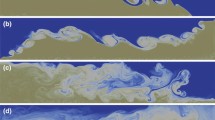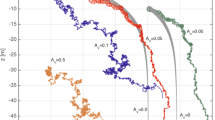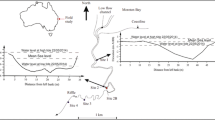Abstract
A two-dimensional horizontal dispersion equation is derived for the many ways that buoyancy modifies the spreading of a mono-disperse discharge of particles in a shallow-water flow. The particle-induced lateral density gradient gives rise to a secondary transverse flow which tends to carry particles outwards. Stratification with the consequent reduced mixing, changes the local vertical profile of the original flow and gives rise to a Burgers nonlinearity (slowing down of sinking particles or a speeding up of buoyant particles). Stratification also modifies the non-local horizontal distribution of the current, with an inflow towards particle-laden regions where the drag is reduced. A simple eddy-diffusivity turbulence model is used which permits explicit evaluation of most of the linear and nonlinear coefficients. Nonlinear effects are shown to be significant for particle volume concentrations of only 10 parts per million.
Similar content being viewed by others
Réferences
H. E. Huppert and J. Simpson, The slumping of gravity currents.J. Fluid Mech. (1980) 785–799.
A. M. Binnie and O. M. Phillips, The mean velocity of slightly buoyant and heavy particles in turbulent flow in a pipe.J. Fluid Mech. 4 (1958) 87–96.
J. W. Elder, The dispersion of marked fluid in turbulent shear flow.J. Fluid. Mech. 5 (1959) 544–560.
A. S. Monin and A. M. Obukhov, Basic regularity in turbulent mixing in the surface layer of the atmosphere.Trudy Geophys. Inst. Akad. Nauk, SSSR, 24 (1954) 163–189.
R. Smith, Longitudinal dispersion of a buoyant contaminant in a shallow channel.J. Fluid Mech. 78 (1976) 677–688.
R. Smith, Buoyancy effects upon lateral dispersion in open-channel flow.J. Fluid Mech. 96 (1979) 761–779.
G. I. Taylor, Dispersion of soluble matter in solvent flowing slowly through a tube.Proc. Roy. Soc. Lond. A 216 (1953) 186–203.
J.C. Giddings, Non-equilibrium theory of field-flow fractionation.J. Chem. Phys. 49 (1968) 81–85.
H. B. Fischer, Longitudinal dispersion and turbulent mixing in open-channel flow.Ann. Rev. Fluid Mech. 5 (1973) 59–78.
J.M. Burgers, A mathematical model illustrating the theory of turbulence,Adv. Appl. Mech. 1 (1948) 171–199.
E. Hopf, The partial differential equation ut+uux=μUxx.Commun. Pure Appl. Maths. 3 (1950) 201–230.
J. D. Cole, On a quasi-linear parabolic equation occurring in aerodynamics.Q. Appl. Maths. 9 (1948) 225–236.
B. M. Sumer, Mean velocity and longitudinal dispersion of heavy particles in turbulent open-channel flow.J. Fluid Mech. 65 (1974) 11–28.
R. Smith, Vertical drift and reaction effects upon contaminant dispersion in parallel shear flows.J. Fluid Mech. 165 (1986) 425–444.
Author information
Authors and Affiliations
Rights and permissions
About this article
Cite this article
Smith, R. A mathematical model for the density-augmented spreading of a particle-laden discharge in a turbulent shallow-water flow. J Eng Math 29, 497–516 (1995). https://doi.org/10.1007/BF00044119
Received:
Accepted:
Issue Date:
DOI: https://doi.org/10.1007/BF00044119




